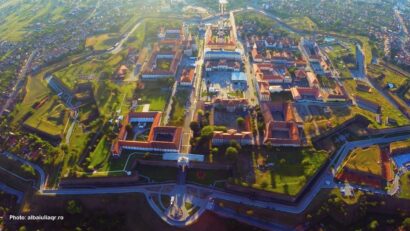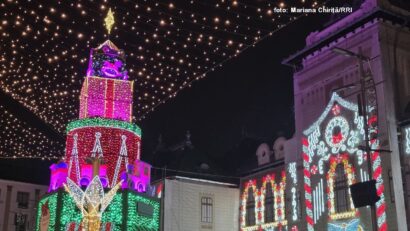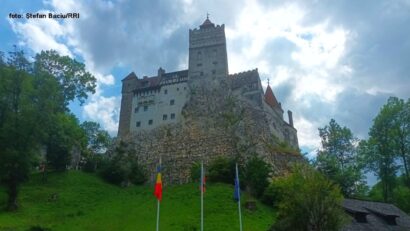Constanta, Tourism City on the Black Sea
With a history of over 2,000 years, Constanța has remained one of the oldest continuously inhabited settlements in Romania

Daniel Onea, 19.06.2025, 13:00
Today we arrive in one of the most important cities in Romania, located in the southeast of the country, on the shores of the Black Sea. With a history of over 2,000 years, Constanța has remained one of the oldest continuously inhabited settlements in Romania. It was founded by Greek colonists under the name of Tomis and became a strategic point during the Roman period. Diana Slav is a tour guide and oenologist, and our journey begins right now.
“Our center is a very compact area, which starts right from the modern city area. There is also a City Hall park, which houses some very beautifully preserved vestiges. They also have descriptive plaques. So you can get to know it with a guide, but also individually. Those who are curious can read to see how old the city of Constanța actually is, and where the first human settlement here started. From there, you can go down various routes to the bottom, on the cliff, and all the streets and almost every house have a story.”
An emblematic place of the city is Ovidiu Square, where there is a statue of the Roman poet Ovid, exiled here by Emperor Augustus. Here is the Museum of National History and Archaeology, which houses important artifacts from the Greek, Roman and Byzantine eras. Although closed during this period for rehabilitation, there are many other museums that we can visit.
“The Art Museum remains a very good option. Even the State Theater has included it in a project. It is called “Highway to the Theater”. Spectators are brought from Bucharest for a full-day program, which also includes a tour with me to this art museum. Then, we have the Museum of Traditional Art. It is also very beautifully arranged. The Navy Museum is unique in Romania because it presents the history of navigation and maritime history for the Black Sea from antiquity to the present. There are exhibits, as well, from antiquity to the present and presents many interesting stories. There is also a Military Museum that belongs to the “King Ferdinand I” National Military Museum in Bucharest. It is also worth visiting. I would also recommend the Ion Jalea Sculpture Museum, which also belongs to the Art Museum. The building of this museum also has an interesting story.”
The Constanta Casino remains one of the most emblematic buildings on the Romanian coast. Built in the art nouveau style at the beginning of the 20th century, it was inaugurated in 1910 as an entertainment venue for the elite. It reopened for visits after being rehabilitated, and its panoramic position offers a spectacular view of the sea. It is a museum objective, as we learned from Diana Slav, our guide.
“During this period, visitors will find there, on one level, an exhibition dedicated to the history of the three casinos that the city of Constanta had. There were several. This activity was probably encouraged. Therefore, investments were made in such buildings. In another room, there is an exhibition dedicated to the engineer Anghel Saligny, obviously, with an emphasis on the Cernavodă bridge and the silos designed here, in Constanta. We learn why the projects are special. For example, the Cernavodă bridge was the longest in Europe. So, we will get to know the engineering innovations behind the creations.”
The most famous beaches in Constanța are Modern Beach, 3 Papuci Beach and Tăbăcărie Beach. All are equipped with sun loungers, terraces, and water sports facilities. The water is relatively calm, and the fine sand attracts many visitors in the summer season. They are also supervised and equipped with lifeguard services, and access is free. And, if you have more time, Constanța can be a good starting point for the attractions in the surrounding area.
“In recent years, we have been included with Dobrogea in some motorcycle or bicycle circuits, because there are some very beautiful landscapes. The roads are very well built, and tourist groups like to explore the areas. Over time, the villagers also started to arrange and organize themselves. Thus, accommodation options in truly picturesque places have also appeared. They can cross Dobrogea all the way up to Tulcea, on various routes, visiting the ancient fortresses. We also have scooter clubs. And these clubs offer such very beautiful excursions. On the other hand, if tourists have a private car, then they can travel at the pace they want, and even tick off even more. If they come individually and do not have their own car, it can be rented. We, the guides, offer such options and even have the same. Otherwise, I explain to them where they have public transportation, how to get to Mangalia, to Tulcea. It’s not impossible, but it takes a bit of organization. But they like it.”
Diana Slav, a tour guide and oenologist, recommends visiting the wineries in Dobrogea. They are famous for their wines made from local and international varieties, grown on the sunny hills between the Danube and the Black Sea. The region offers an attractive combination of wine-growing landscape, tradition and local gastronomy.
“We have very good vineyards, and the wineries have also started to be very open to such groups of visitors. I also got my sommelier certification in the last 2 years, which, obviously, comes in addition to the history. The tours can start in the morning, but not right from the first hour, from 10:00 to around 18:00, because some of the wineries are very well positioned, right in the vineyard or even on a hill. The sunset is often spectacular there. Others are a little more industrialized and, then, the magic happens inside, and there the time doesn’t matter. In the first phase, there is always a visit to the winery. For many, it is often a first, and they don’t understand all the technology. There is a whole lot of magic there, but very well and meticulously organized by these winemakers. They emphasize local varieties. In Dobrogea, having a lot of sun, sandy or calcareous soil, the humidity and salinity from the sea provide a complement to certain varieties, but they also highlight them in a different way. It’s another form of history here too.”
So here is a city that combines the past with the present, history with relaxation, and culture with fun! A suitable destination for both history lovers and those looking for relaxation on the coast.






























